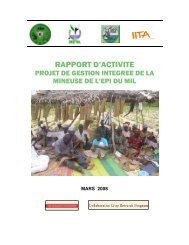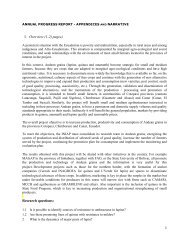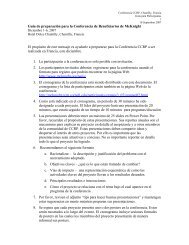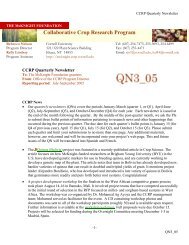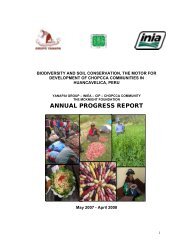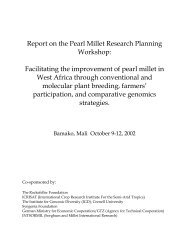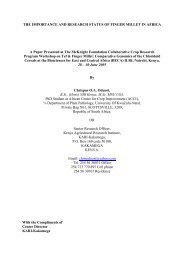English - McKnight Foundation Collaborative Crop Research Program
English - McKnight Foundation Collaborative Crop Research Program
English - McKnight Foundation Collaborative Crop Research Program
Create successful ePaper yourself
Turn your PDF publications into a flip-book with our unique Google optimized e-Paper software.
<strong>McKnight</strong> <strong>Foundation</strong> <strong>Collaborative</strong> <strong>Crop</strong>s <strong>Research</strong> Project No: 06-741<br />
Objective 2: Promotion of high yielding A. vogelii resistant cowpea varieties<br />
With the continuation of the on-farm trials/demonstration component of the project efforts to increase<br />
awareness of the problem of A. vogelii and approaches to management continued in year 3. Work<br />
implemented included farmers field exchange visits, participation in national agricultural shows, training<br />
on preparation of different cowpea recipes and some market studies in Malawi<br />
Output 2.1: Farmer and extension awareness of .A. vogelii and use of resistant cultivars enhanced<br />
In the implementation of the above mentioned output, two activities were conducted in Tanzania, these are<br />
farmer field days and exchange visits and participation in 2009 National Agricultural show. With respect to<br />
exchange visit, twelve farmers from Mangalali (Ari Mpya Group) visited Mkungugu (Fahari research<br />
group) and later both visited Ismani On-station trials in Iringa. The objective of the farmer exchange visit<br />
was for farmers from Mangalali to share experiences with other farmers on principles of cowpea<br />
production, processing and utilization and to be acquainted with on station cowpea lines screening work. At<br />
the research station farmers participated in evaluation of 14 cowpea screening materials planted. Four<br />
cowpea farmers of the CCRP project from Singida rural district (two from Msungua and two from<br />
Ikhanoda) were sponsored by their district council and attended the National Agricultural Show between 1 st<br />
and 8 th August 2009 in Dodoma. Promising cowpea lines and associate processed products of cowpea from<br />
their group were displayed.<br />
In Malawi, farmers from Mngwangwa EPA, on their own accord, organized themselves and participated at<br />
a District Agriculture Fair held in the same EPA in June 2009. The farmers demonstrated a range of<br />
cowpea products based on the training made by the project and shared this with participants. In addition,<br />
the project team participated at a national agriculture fair, alongside the <strong>Crop</strong> Science Department. Again,<br />
the focus of the exhibit was on utilization. The exhibits attracted a lot of attention from participants<br />
Output 2.2a: Nutritional status of farmers improved<br />
To accomplish output 2.2 above, activity 2.2.2: (Develop/modify/ demonstrate cowpea products) was<br />
undertaken. The primary objective was to promote the utilization of cowpea in Tanzania. Specifically was<br />
to train farmers on the processing of cowpea grains into dhal, preparation of cowpea dishes (snack bites<br />
from cowpea flour “bagia’); and to perform sensory evaluation and organoleptic tests. The training was<br />
conducted in eight villages namely Msungua, Ikhanoda, and Nduu in Singida region, Kikombo and<br />
Mpunguzi in Dodoma region and Mkungugu, Ilambilole and Mangalali in Iringa region. The villages were<br />
purposively selected as a result of their involvement in a project on “Improvement of cowpea productivity<br />
on Alectra Vogelii infested land in Tanzania. A one day workshop was conducted in each project village<br />
and farmers were trained on improved cowpea technologies. The trainings were based on demonstrations,<br />
hands-on trials and printed materials (brochures for cowpea recipes). Farmers participated in the validation<br />
of five recipes for cowpea value addition. Sensory and organoleptic tests were carried out, where by<br />
farmers were required to rank and find out the most preferred types of ”bagia”. The five types of bagia<br />
were made using different recipes. The recipes were translated into Swahili language for better<br />
understanding by farmers.<br />
Table 7: Cowpea snack product recipes<br />
Type of<br />
Materials/ingredients<br />
Bagia<br />
1. Bagia asilia Cowpea dhal/flour, salt, cooking oil, water<br />
2. Bagia asilia na viungo Cowpea flour, salt, cooking oil, garlic, onions and water<br />
3. Bagia; viungo na hamira Cowpea flour, salt, cooking oil, onions, garlic, yeast and water<br />
4. Bagia; viungo na mayai Cowpea flour, salt, cooking oil, garlic, onions, eggs and water<br />
5. Bagia; viungo, mayai na hamira Cowpea flour, salt, cooking oil, onions, garlic, eggs, yeast and<br />
water<br />
13<br />
2009



